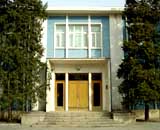

| yAbout Venezuela > Trade & Economy | |||||
|
The economy of Venezuela is built
upon the nation's rich petroleum and mineral resources. While resource
extraction has assisted in developing an industrial economy, the
nation is vulnerable to fluctuations in world markets. ECONOMIC
INDICATORS (charts and tables) |
|||||
|
|||||
| .Agriculture | |||||
|
The Venezuelan government passed the Agrarian Reform Law in 1960, which is aimed at expanding and diversifying agricultural production. Agriculture, including forestry and fishing, employed 13 percent of the workforce; in 1998 it contributed 5 percent of the GDP. The main crops include sugarcane (7.1 million metric tons in 1999); fruits such as bananas, plantains and oranges (2.8 million); maize (1 million); rice (722,000); cassava (487,685); and coffee (78,000). Livestock raising is carried on chiefly on the Llanos and east of Lake Maracaibo. In 1999 the livestock population numbered 12.7 million head of cattle, 3.2 million hogs, 4 million goats, 0.8 million sheep and 100 million poultry. |
|||||
| .Forestry and Fishing | |||||
|
Although forests cover much of Venezuela,
the timber industry is underdeveloped largely because of the inaccessibility
of the forest areas. Timber is used mainly as fuel and by the building,
furniture manufacturing and paper industries. In 1998, 2.2 million
cubic meters (76 million cubic feet) of timber were produced. |
|||||
| .Mining | |||||
|
Petroleum, located in the Maracaibo
Basin and in the eastern part of the country, dominates the Venezuelan
economy. Crude and refined oil are the main source of government
revenue and account for about one-quarter of the GDP. In 1997 Venezuela
produced 1.16 billion barrels. Much of its oil is exported to the
Netherlands Antilles for refining. Venezuela is a founding member
of the Organization of Petroleum Exporting Countries (OPEC). The
Venezuelan government nationalized the petroleum industry in 1976,
although private investment and foreign participation has been permitted
since 1992. The country has petroleum reserves estimated at 78 billion
barrels, including those in an oil field discovered in 1989, which
increased known reserves by at least one-third. The country also
is a major producer of natural gas; output in 1998 was 28.3 billion
cubic meters (0.99 trillion cubic feet). Venezuela has tapped its
vast reserves of bitumen to produce liquid coal, an emulsion of
bitumen and water mainly for use in power plants. |
|||||
| .Manufacture | |||||
|
Since the early 1960s the government of Venezuela has given high priority to the development of the manufacturing sector of the economy. Founded in 1961 in an area rich in natural resources, Ciudad Guayana is now a major center for industrial development. The leading manufactures of Venezuela include refined petroleum and petroleum products, steel, aluminum, fertilizer, cement, tires, motor vehicles, processed food, beverages, clothing and wood items. |
|||||
| .Energy | |||||
|
Much of Venezuela's electricity is produced in hydroelectric facilities, particularly at the Guri Dam, a major installation on the Caron� River. Venezuela generated 70 billion kilowatt-hours of electricity in 1998. |
|||||
| .Currency and Banking | |||||
|
The basic unit of currency is the
bolivar, consisting of 100 centimos. The Central Bank of Venezuela,
founded in 1940, is the government banking agent, the sole bank
of issue and the clearinghouse for commercial banks. The country's
main stock exchange is in Caracas. |
|||||
| .Foreign Trade | |||||
|
The main exports of Venezuela are petroleum and petroleum products, which together account for 79 percent of foreign sales. Other exports include bauxite and aluminum, steel, chemicals, agricultural products and basic manufactures. Total exports were estimated at $17.5 billion in 1998. Main imports include raw materials, machinery, transportation equipment, chemicals, foodstuffs and basic manufactures. Imports were estimated at $16.8 billion in 1998. Major trading partners for exports are the United States, Japan, The Netherlands (primarily petroleum to the Netherlands Antilles for refining) and Italy. Chief sources of imports are the United States (which represents 50 percent of the total sales), Germany, Japan, The Netherlands and Canada. Venezuela is a member of four international trade organizations, the Andean Group, Latin American Integration Association (LAIA), Group of Three and the Association of Caribbean States (ACS). These organizations work toward improving conditions within member countries by increasing economic integration and international trade. |
|||||
| .Transportation | |||||
|
In 1998 Venezuela had 96,155 km (59,748 mi) of roads, of which 34 percent were paved. Highway density was greatest in the north central area, with an extensive highway system under construction to connect major urban centers and remote rural areas. In 1997 the country had only 396 km (246 mi) of operated railroad track, mainly a line from Puerto Cabello to Barquisimeto. The leading seaports of Venezuela include La Guaira, Puerto Cabello and Maracaibo. Transport on interior waterways, particularly the Orinoco River is also important. |
|||||
| .Communications | |||||
|
In 1998 Venezuela had some 117 telephone lines for every 1,000 people. The country's phone system was privatized in 1991, leading to a substantial increase in service. An estimated 180 television sets and 472 radios were in use for every 1,000 residents. Influential daily newspapers included El Nacional and El Universal, published in Caracas. |
|||||
| .Recommended Links | |||||
| Caracas Stock Exchange (E/S) | |||||
| Central Bank of Venezuela (E/S) | |||||
| CONAPRI - Nacional Council for Investment Promotion (E/S) | |||||
| CVG - Venezuelan Guayana Corporation (S) | |||||
| Foreign Commerce Bank (S) | |||||
| Investment Fund of Venezuela (S) | |||||
| Ministry of Production and Commerce (S) | |||||
| OCEI - Central Agency of Statistics and Informatics (S) | |||||
| Oil Guide of Venezuela (S) | |||||
| PDVSA - Venezuela's Petroleum (E/S) | |||||
| SIDOR - Orinico's Metallurgy (S) | |||||
| E: English, S: Spanish, O: Other languages | |||||
Trade & Economy | Business Opportunities | Tourism | Downloads | Links | Contact Us